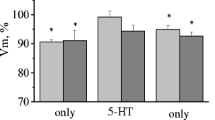Abstract
An investigation was carried out on a preparation of the isolated nervous system of the edible snail of the mechanism of habituation in the network of defense behavior neurons. It was established that the intracellular activation of one of the systems of the defense behavior command neurons, as in the case of the application of the neuropeptide FMRF-amide, leads to a decrease in the amplitude of the postsynaptic potentials in the remaining neurons of this class. An inference is reached, when account is taken of the presence of endogenous FMRF-amide in the defense behavior command neurons, regarding the possibility of active inhibition of the behavioral response to an appropriate stimulus through this neurochemical mechanism of the backward connection. The possible interrelationships with other modulating systems and the significance of such an association in the organization of behavior are discussed.
Similar content being viewed by others
References
E. Kandel,Cellular Bases of Behavior [Russian translation], Mir, Moscow (1980), pp. 598.
O. A. Maksimova and P. M. Balaban,The Neuronal Mechanisms of Plasticity of Behavior [in Russian], Nauka, Moscow (1983), pp. 126.
E. N. Sokolov,Perception and the Conditioned Reflex [in Russian], Izd-vo MGU, Moscow (1958), pp. 280.
G. Horn,Memory, Imprinting, and the Brain [Russian translation], Mir, Moscow (1988), pp. 340.
P. M. Balaban, “A system of command neurons for avoidance behavior of the snailHelix lucorum”Acta Neurobiol. Exper.,39, No. 2, 97–107 (1979).
P. M. Balaban, “Postsynaptic mechanisms of withdrawal reflex sensitization in the snail,”Neurobiology,14, No. 5, 365–375 (1983).
P. Balaban and R. Chase, “Inhibition of cells involved in avoidance behavior by stimulation of mesocerebrum,”J. Compar. Physiol.,166, No. 3, 421–427 (1990).
F. Belardetti and S. A. Siegelbaum, “Up- and down-modulation of single potassium channel function by distinct second messengers,”Trends Neurosci.,11, No. 5, 232–238 (1988).
K. Elekes and D. R. Nassel, “Distribution of FMRFamide-like immunoreactive neurons in the central nervous system of snailHelix pomatia,”Cell. Tiss. Res.,262, No. 1, 177–190 (1990).
R. F. Thompson and W. A. Spenser, “Habituation: a model phenomenon for the study of neuronal substrates of behavior,”Psychol. Rev.,173, 16–43 (1966).
I. S. Zakharov and P. M. Balaban, “Serotonergic neurons modulate avoidance behavior in Helix,” in:Simple Nervous Systems, W. Winlow (ed.), Manchester Univ. Press, London (1991), pp. 316–329.
Author information
Authors and Affiliations
Additional information
Translated from Zhurnal Vysshei Nervnoi Deyatel'nosti imeni I. P. Pavlova, Vol. 41, No. 5, pp. 1033–1038, September–October, 1991.
Rights and permissions
About this article
Cite this article
Balaban, P.M., Bravarenko, N.I. & Zakharov, I.S. The neurochemical basis of backward inhibition in a defense reaction reflex arc. Neurosci Behav Physiol 23, 24–28 (1993). https://doi.org/10.1007/BF01182634
Received:
Revised:
Issue Date:
DOI: https://doi.org/10.1007/BF01182634




